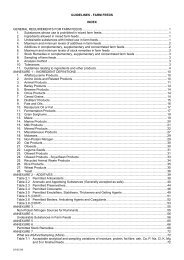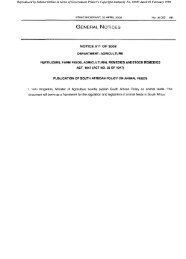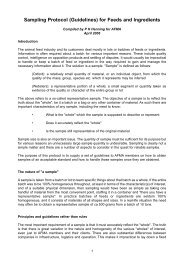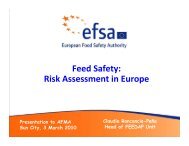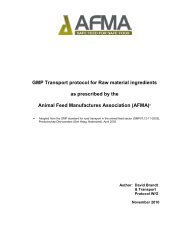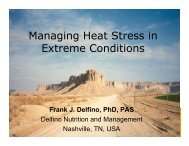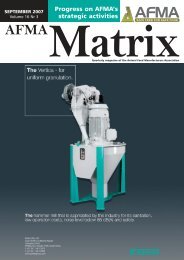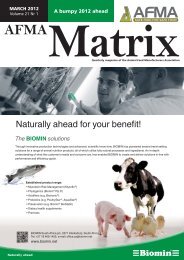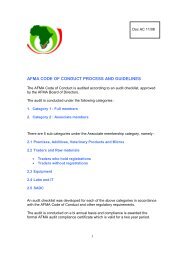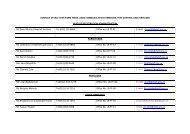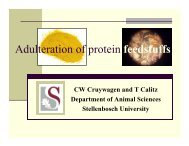Create successful ePaper yourself
Turn your PDF publications into a flip-book with our unique Google optimized e-Paper software.
Factors affecting the<br />
voluntary feed intake of livestock<br />
By Foch-Henry de Witt and Ockert Einkamerer, University of the Free State, Bloemfontein<br />
We often assume that<br />
because there is 15%<br />
protein or 60% carbohydrate<br />
in a ration,<br />
that the animal has to<br />
use all of it. This assumption is not true.<br />
In fact, we must consider that even the<br />
ingested nutrients are still “outside” the<br />
body until it has been absorbed. When<br />
any animal is presented with food, for<br />
some reasons that may not be known,<br />
the animal may consume 95 units of this<br />
material and refuse the balance.<br />
Increasing intake of high-producing<br />
animals is essential, but care must be<br />
taken to prevent metabolic disorders<br />
and excessive fat accumulation closer to<br />
the end of the feeding period. Feeding is<br />
a complex activity which includes such<br />
actions as the search for food, recognition<br />
and movement towards it, sensory<br />
appraisal, the initiation of eating and ingestion.<br />
It is necessary to consider why, in<br />
most mature animals, body weight is<br />
maintained more or less constant over<br />
long periods of time, even if feed is available<br />
ad libitum. Hence, the concepts of<br />
short- and long-term control of food<br />
intake must be considered. The former<br />
concerns initiation and cessation of individual<br />
meals, and the latter the maintenance<br />
of a long-term energy balance.<br />
Although thought to be similar, there are<br />
important differences between species.<br />
This depends mainly on the structure<br />
and function of their digestive tracts.<br />
Non-ruminants<br />
The most problematic factor in diet formulation<br />
for monogastric animals is<br />
probably the correct prediction of voluntary<br />
feed intake (VFI). Although diet formulators<br />
are normally skilled in the use<br />
of software programmes for “least-cost”<br />
formulation, they should continuously<br />
strive to improve their biological knowledge<br />
regarding the factors influencing<br />
VFI. The followings aspects will be briefly<br />
discussed to indicate their importance in<br />
VFI of pigs and chickens.<br />
Feed<br />
Due to the limited nutrient contribution<br />
of microbial fermentation in monogastric<br />
animals, pigs and chickens normally consume<br />
feed in accordance with the diet’s<br />
first limiting nutrient – thus any shortage<br />
of amino acids, minerals, vitamins and<br />
energy would provoke an increase in VFI.<br />
Additionally, the amino acid profile as<br />
well as the lysine against apparent metabolisable<br />
energy (AME) ratio, must concur<br />
with the requirements of the specific<br />
requirements of the animal.<br />
Generally, it is assumed that a decrease<br />
in dietary energy would result in<br />
an increase in VFI to compensate for the<br />
energy loss, until GUT capacity becomes<br />
the limiting factor. It is indicated that the<br />
threshold energy value for poultry is between<br />
10,1 and 10,8 MJ AME/kg, depending<br />
on the environmental temperature,<br />
thereby suggesting that an energy intake<br />
below these values would negatively influence<br />
lean protein growth in favour of<br />
adipose tissue deposition.<br />
The physical form of the diet (wet/dry<br />
mash, crumbs and pellets), as well as particle<br />
size and the distribution of particles<br />
(% particles ≥1,0 mm & ≤3,5 mm), would<br />
not only influence VFI but also total available<br />
nutrient intake, rate of passage and<br />
digestibility coefficients of a given diet.<br />
Nutrient density or “bulkiness” of diets,<br />
which are mostly linked to the AME and<br />
crude fibre (CF) concentration of diets,<br />
plays an important role in VFI, especially<br />
in young animals with limited GUT capacity<br />
and a high rate of passage due to<br />
the rate of nutrient metabolism.<br />
In addition to that, the water-holding<br />
capacity (WHC) and non-starch polysaccharide<br />
(NSP) component of certain feed<br />
sources (especially if no synthetic enzymes<br />
are included and the diet was not<br />
exposed to heat/steam treatment) will<br />
impede VFI due to its interference with<br />
the rate of passage and digesta viscosity.<br />
“It is highly unlikely that feed<br />
with such a high PV will be fed to<br />
pigs and chickens under<br />
commercial conditions.<br />
It is also known in poultry that<br />
the relationship between water<br />
consumption and feed intake is<br />
linear”<br />
Feed acceptability due to rancidity<br />
“off odours” or “sourness” from wet fermentation<br />
of diets represent a classical<br />
interaction between “feed qualities versus<br />
animal tolerance” which will influence<br />
VFI – mostly in a negative manner.<br />
Although some literature indicates that a<br />
dietary peroxide value (PV) of 75 to 150<br />
milli-equivalent peroxide per kilogram<br />
fat had no negative effect on feed intake<br />
and production performances of birds, it<br />
remains open for debate.<br />
It is highly unlikely that feed with<br />
such a high PV will be fed to pigs and<br />
chickens under commercial conditions.<br />
It is also known in poultry that the relationship<br />
between water consumption<br />
and feed intake is linear. Any factor that<br />
influences water intake (WI) would subsequently<br />
influence VFI. Simultaneously,<br />
water quality in terms of chemical and<br />
microbial contaminants will influence WI<br />
and eventually VFI of the animals due to<br />
Processing<br />
<strong>AFMA</strong> MATRIX ● APRIL <strong>2013</strong> 29



